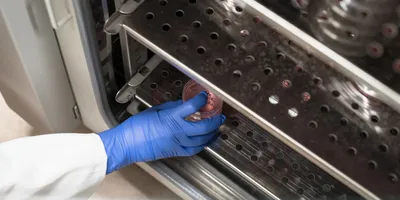Enter any lab and you’ll see so many safety signs, laboratory hazard symbols, and risk messages that you’re likely to be overwhelmed. But what do they all mean?
There are plenty of lab safety symbols and signs to cover most, if not all, hazard types and lab safety risks. But they only work if they help warn people ahead of time. Ideally, they should mitigate the risk each one represents. Lab safety symbols and signs are also just one key component to a successful lab safety culture. There are a variety of lab safety rules and guidelines to follow as well.
Disclaimer: Please note that the graphics below represent our own creative take on the standard lab safety symbols and signs and are not meant to be used in the laboratory. For the official red diamond GHS lab safety symbols, see the OSHA QuickCard.
Physical Safety Symbols
1. Gloves Required

Look for the "gloves safety" symbol and hazard signs to identify when hand protection should be worn for handling hazardous materials, even in small quantities. It is important to choose the appropriate type of glove for the hazard present, such as chemical resistant gloves, heat resistant gloves, etc. Be aware that no chemical resistant glove protects against all chemical hazards. Read the Safety Data Sheet for guidance on the appropriate type of glove to wear or consult with lab supply distributors for glove vs. chemical comparison charts when choosing chemically resistant gloves. Be aware that some materials may cause reactions in some workers such as allergies to latex. Make sure the gloves fit properly. Poor fitting gloves can cause problems such as tears and reduced dexterity resulting in mishandling chemicals.
2. Boots Required
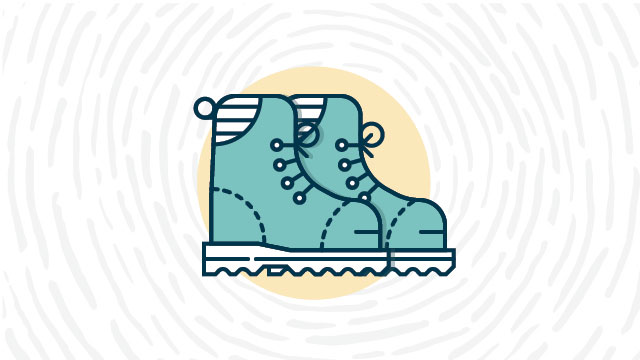
The “boots required” lab safety symbols and signs indicate when regular shoes are not adequate for certain lab-related tasks. Chemical resistant overshoes or boots should be used to avoid possible exposure to corrosive chemicals, solvents, or water that might permeate everyday footwear. Leather shoes tend to absorb chemicals and may have to be discarded if contaminated with a hazardous material. In a lab, dropping a beaker of acid will soon ruin an ordinary pair of shoes. Specialized chemical-resistant footwear is designed for specific applications and settings.
3. Lab Coats (or Other Protective Clothing)

The “lab coat” safety symbol indicates that a lab coat needs to be worn. There are several types of lab coats for different types of protection. Cotton protects against flying objects, sharp or rough edges, and is usually treated with a fire retardant. Since many synthetic fabrics can adhere to skin when burning, cotton is the most preferred laboratory clothing fabric. Wool protects against splashes of molten materials, small quantities of acid, and small flames. Synthetic fibers protect against sparks and infrared or ultraviolet radiation. Other forms of protective clothing may be needed for special hazards like blood, heat, or gross amounts of materials or splashes. For example, aluminized and reflective clothing protects against radiant heat.
4. Safety Glasses or Goggles

The “eye protection” lab safety sign indicates there is the possibility of chemical, environmental, radiological, or mechanical irritants and hazards in the laboratory. Lab safety equipment like glasses and goggles not only provide protection against flying debris and chemical splashes in the lab, respectively, but may also protect against visible and near visible light or radiation from UV rays, depending on the lens material. The most popular lens material for lab safety eyewear is polycarbonate. This material has less than half the weight of glass, making the eyewear more comfortable to wear. Modern safety eyewear designs offer anti-slip nose bridges, anti-fog lenses, and coatings, which make them resistant to acids, caustics, and hydrocarbons.
5. Respirators
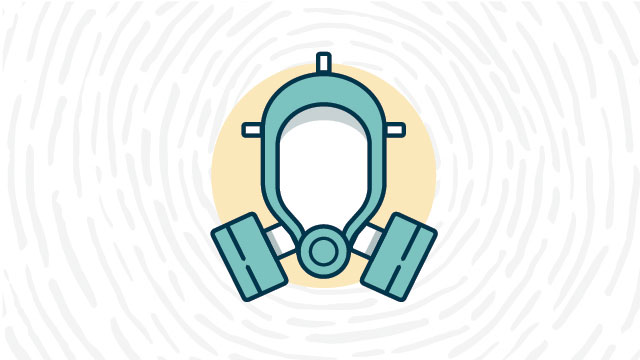
Respirators are designed to prevent contaminated air from being breathed in. “Half face” respirators cover just the nose and mouth; “full face” respirators cover the entire face; and “hood” or “helmet” style respirators cover the entire head. Respirators can protect the user in two ways: It cleans “dirty” outside air by physical filtration, chemical adsorption, or both when one inhales; or by supplying clean breathing air from a clean source. The clean air can either be delivered via a supply line, or the clean air is compressed and carried with you in a tank. The “respiratory protection” lab safety symbols and signs symbols let you know that you’re working in an area with potentially contaminated air.
Lab Safety Management Certificate
The Lab Safety Management certificate is more than training—it’s a professional advantage.
Gain critical skills and IACET-approved CEUs that make a measurable difference.
6. Face Shields

The “face protection” lab safety symbol lets lab personnel know that a large face shield must be worn when experiments can potentially cause liquids or solids to be projected at your face. Full face (and possibly throat) protection from splash and/or impact is commonly required for work on or in the presence of human pathogens, some laboratory chemicals, explosion hazards, heavy grinding and heavy spraying or splashing, and with quantities of dangerous liquids such as acids, bases, and many organic liquids. A face shield can also afford extra protection against radiant heat and cryogens.
7. Hearing Protection

Noise in laboratories is a growing concern. While the noise levels in many laboratories are below regulatory limits, some hearing damage is possible. Plus, laboratory noise often varies over time, place in the lab, and by process or equipment. The operation of large analyzers (e.g., chemistry analyzer), fume hoods, biosafety cabinets, incubators, cell washers, tissue homogenizers, and stirrer motors, all contribute to the noise level. There is a wide variety of hearing protection devices available including muffs, plugs, and other types. Different devices are designed to protect against different severities of noise. The “ear protection” lab safety symbol indicates that lab workers must wear hearing protection devices in the lab.
8. Eye Wash Station

The “eye wash” safety sign indicates the location of an eyewash station. Eye wash stations provide a continuous, low-pressure stream of aerated water in laboratories in which chemical or biological agents are used or stored and in facilities where nonhuman primates are handled. The eyewash station should be easily accessible from any part of the laboratory and, if possible, located near the safety shower so that, if necessary, the eyes can be washed while the body is showered. It’s vital to not place or store any materials that could impede a victim from quickly accessing it safely.
9. Safety Shower

Safety showers need to be installed in all areas where laboratory employees may be exposed to splashes or spills of materials that may be injurious to the eyes and body. As a general rule, new shower installations should adhere to the recommendations for shower location and minimum performance requirements established in American National Standard Z-358.1 (1998). Showers should be placed as close to the hazard as possible, but in no case more than 10 seconds of travel time from the hazard. Safety shower signage should be prominently displayed close to the shower. Install privacy or modesty curtains to ensure victims feel protected while disrobing in an emergency when time is of the essence.
10. Wash Hands
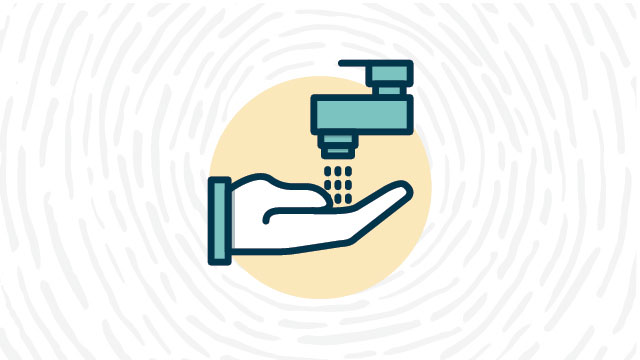
Hand washing is a primary safeguard against inadvertent exposure to toxic chemicals or biological agents. The “wash hands” safety sign lets lab personnel know to wash their hands after removing soiled protective clothing, before leaving the laboratory, and before eating, drinking, smoking, applying lip balm or cosmetics, or using a rest room. Workers should also wash their hands periodically during the day at intervals dictated by the nature of their work. Wash with soap and running water with hands held downward to flush the contamination off the hands. Turn the tap off with a clean paper towel to prevent contaminating them, and dry hands with clean towels.
11. Food & Drink Prohibited

“No food and drink” lab safety signs let lab personnel know that eating or drinking where hazardous materials are used, handled, or stored is not permitted. Eating or drinking has resulted in accidental ingestion of hazardous materials (chemical, biological, and/or radiological). Food or beverage containers may not be stored in the laboratory. Drinking cups, food containers, or eating utensils may not be dried on laboratory drying racks. Refrigerators used for storage of research materials must not be used for food or beverages.
12. No Pacemakers or Metallic Implants
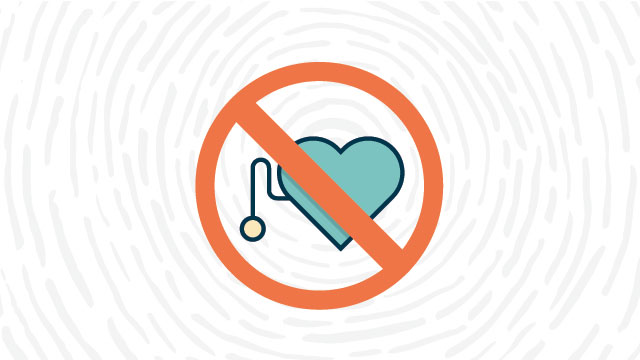
"No pacemakers or metallic implants” lab safety symbols are used to warn lab staff of a strong magnetic field hazard. This is caused by lab instruments that use superconducting magnets such as nuclear magnetic resonance spectrometers (NMR). Staff with pacemakers or metallic implants cannot work in such areas of the lab and other staff should take care to remove metal objects such as keys, jewelry, watches, metal-frame glasses, loose change, etc. before entering these areas, to prevent injuries.
Fire Safety Symbols
13. Fire Extinguisher
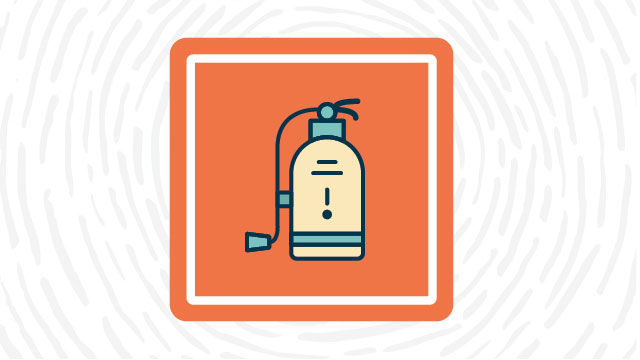
Fires can happen anywhere, but lab fires can be even more dangerous due to Bunsen burners, flammable gases and liquids, reactive chemicals, electronics, and lab equipment that might be present at any given time. Due to these unique circumstances, it’s important that every lab be prepared with the correct fire extinguisher, inspection requirements, and training. It is essential that people in labs are fully aware of the risks and the appropriate extinguishing media. A fire extinguisher safety sign indicates the exact location of a lab’s fire extinguisher, often near the exit.
14. Fire Blanket

Although blankets aren’t as commonly used, the fire blanket safety sign indicates where a fire blanket is in the lab. Housed in a case or not, the woolen blanket is used for smothering fires and for containing and controlling chemical spills.
If someone in the lab should catch fire, he or she should stop, drop, and roll around to extinguish the flames. Lab personnel can assist by using the blanket to facilitate this, preventing further injury. Fire blankets are large enough to entirely cover most people, depriving the fire of the oxygen that it needs to continue burning. Don’t roll the victim into the blanket as the cylinder-like shape can create a chimney effect.
15. Fire Hose

"Fire hose connection” lab safety symbols inform individuals of the location of hose connections in their lab even if there is no longer a hose connected as is now common. Those locations should be clearly and accurately marked so they can easily be found. The best safety practice is to post a fire hose connection location sign above the actual equipment and then install directional versions of the fire hose location sign (which point towards the direction to the equipment) wherever people cannot actually see a fire hose’s location or its “above-the-equipment” sign.
16. No Open Flames

Bunsen burners, lighters, matches, and any other flame-producing devices are considered “open flame devices.” Open flame devices carry with them the risk of unintentional fire and serious consequences when not used safely. Most organic chemicals are flammable. The chance of a fire is substantially increased when open flames are present. “No open flames” lab safety symbols indicate to lab personnel the risk and prohibition of open flame devices.
First Aid Symbols
17. First Aid Station
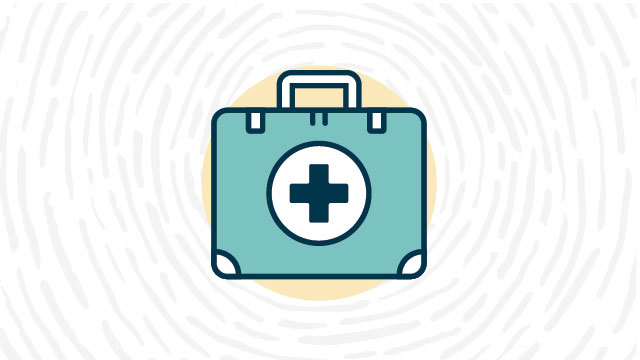
The first aid station safety symbol indicates the availability and location of a first aid kit. The kit should be easily accessible to other lab locations that belong to a particular group. The first aid kit should contain the items recommended in the lab’s first aid policy or plan. These should be based on potential injuries. Its contents should be inspected monthly to ensure that no items are missing and that none of the remedies (e.g., saline solution, ointment) in the kit have expired. Special treatments may be needed such as calcium gluconate for HF acid use.
18. AED or Defibrillator
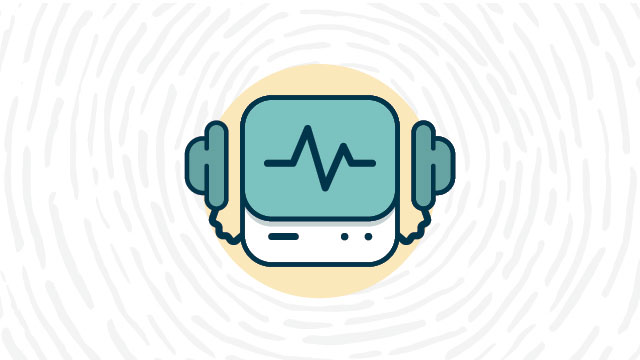
The AED or defibrillator safety sign indicates the location of the laboratory’s automated external defibrillator (AED) so that it can be found quickly in the event of an emergency. This portable device, used to treat sudden cardiac arrest, checks the heart rhythm, and can send an electric shock to the heart to try to restore a normal rhythm. Ideally, lab staff should be trained on how to use the AED, but each unit comes with instructions so that even untrained staff can operate it if necessary. Doing CPR in conjunction with using the AED can also improve chances of survival for someone experiencing sudden cardiac arrest in the lab.
19. Emergency Meeting Point

"emergency meeting or rally point” lab safety symbols mark a safe place, either inside or outside the building, where laboratory employees should meet in the event of an actual emergency (chemical spill, fire, etc.) or emergency drill. In their safety training, employees should be made aware of the location of the emergency point, or the meeting point closest to their location if there are multiple meeting points. Such locations should be large enough to accommodate all employees in the event of an evacuation. It’s always a good idea to have a backup meeting point in case the primary one is unusable or inaccessible due to the emergency taking place.
Laboratory Hazard Symbols
20. General Warning
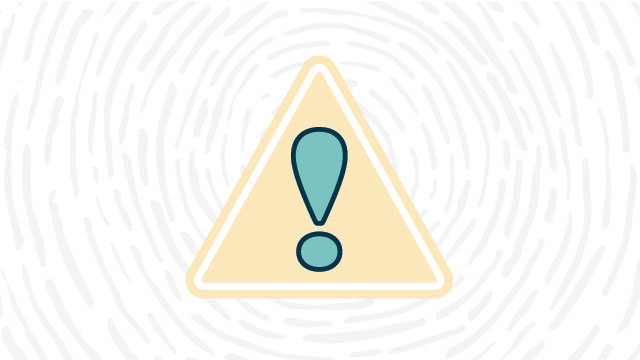
"General warning” lab safety symbols consist of a black exclamation point in a yellow triangle. As you’d expect, it is a general warning to laboratory staff that a hazard exists. This lab safety symbol can be found on equipment, doorways, cupboards, or other areas of the lab. It provides a good reminder to work safely and check if you are not sure of the safety procedures for certain equipment or areas in the lab.
21. Health Hazard
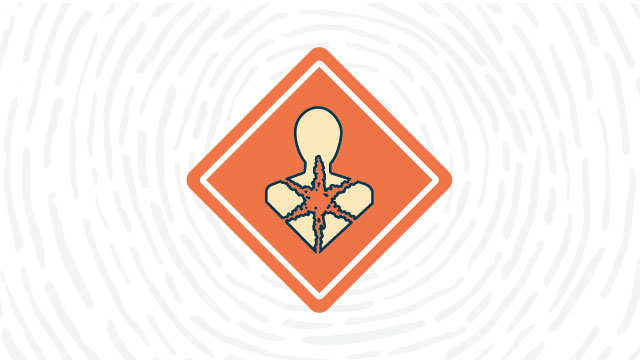
The “health hazard” sign denotes chemicals in the lab that can cause serious, often long-term or chronic health problems. Hazards include carcinogens, respiratory sensitizers, reproductive toxins, aspiration toxins, target organ toxins, and mutagens. An important step in protecting worker health is recognizing the various health hazards in the lab, as ignorance of the harmful effects of laboratory materials can have serious and even fatal consequences.
22. Biohazard
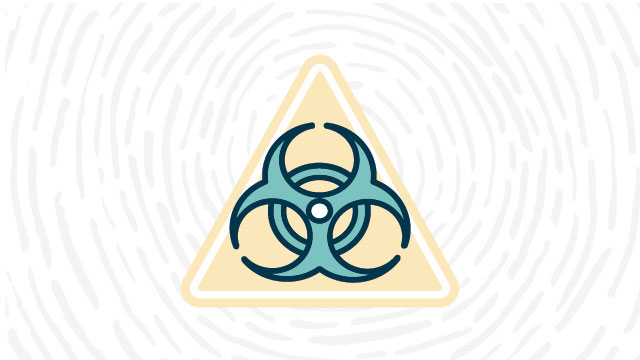
"Biohazard" lab safety symbols warn of lab equipment such as fridges or freezers that contain biohazards or materials contaminated with biohazards such as blood samples. This sign also marks entire areas of the lab that either contain or are exposed to biohazards, for example, a lab working with infectious agents. Workers should always wear the proper PPE and follow proper procedures when working with such agents. Managers should also have an effective exposure control plan in place in case of an emergency. Regular cleaning and decontamination of areas and equipment that are exposed to biohazards is also a must.
23. Harmful Irritant

Substances labeled with the irritant lab safety symbol are not necessarily corrosive, but they can cause discomfort and reddening, irritation, or blistering of the skin. Laboratory workers should handle irritants carefully. Working with irritants in the fume hood can help individuals avoid inhalation. Examples of irritant substances include ammonia, chloroform, and chlorine.
24. Poisons or Toxins

"Toxic material" lab safety symbols indicate the presence of substances that may harm an individual if they enter the body. Possible routes of exposure to toxic materials are through inhalation, skin contact or absorption, ingestion, or injection. The hazards and health effects associated with toxic materials depend on the specific material in question, the route of exposure, target organ(s) affected, physiologic response, and the concentration of the material.
25. Corrosive Material Hazard
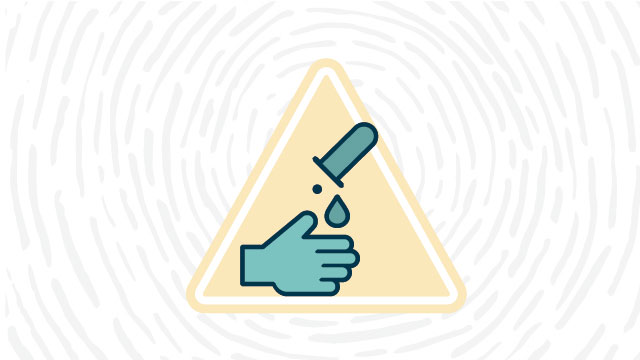
The corrosive material hazard warning sign indicates corrosive substances in the lab that can eat away at the skin if you come into direct contact with them. Such materials should always be stored properly, in the correct containers and cabinets. Environmental conditions should always be appropriate for the chemicals being stored or used. All employees who handle corrosive substances should be properly trained and wear gloves, protective clothing, and face protection.
26. Carcinogen Hazard Warning Sign

Carcinogen signs in a laboratory indicate the use of known human carcinogens. Carcinogenic substances commonly used in the lab include formaldehyde, methylene chloride (also called dichloromethane or DCM), and benzene. When handling carcinogens, appropriate personal protective equipment must be worn. To keep carcinogens contained, lab safety equipment such as fume hoods, glove boxes, and HEPA filters are often used to limit unnecessary exposure.
27. Explosive Hazard

Exploding bomb lab safety symbols will appear on energetic materials or chemicals in the lab that have explosive properties; these include unstable explosives (solid or liquid chemicals capable of a chemical reaction that damages surroundings), self-reactive substances and mixtures (substances and mixtures that may cause fire or explosion in the absence of air), and organic peroxides.
28. High Voltage
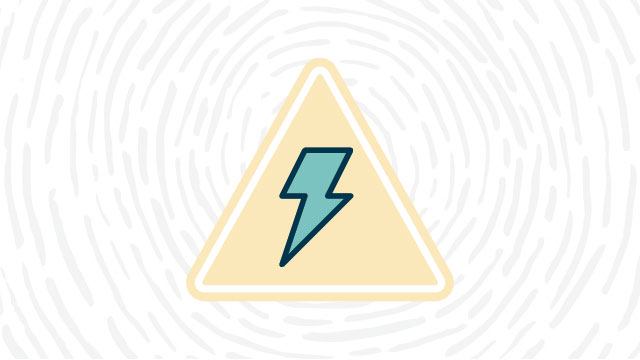
The high voltage warning lab safety symbol, which includes a lightning bolt arrow in a yellow triangle, warns of voltage or amperage high enough to cause serious injury or death. You should stay away from equipment or areas of the lab marked with this symbol, though if you do need to work close to such hazards, training and employer authorization are needed. Protective clothing and rubber gloves should be worn.
29. Electrical Hazard
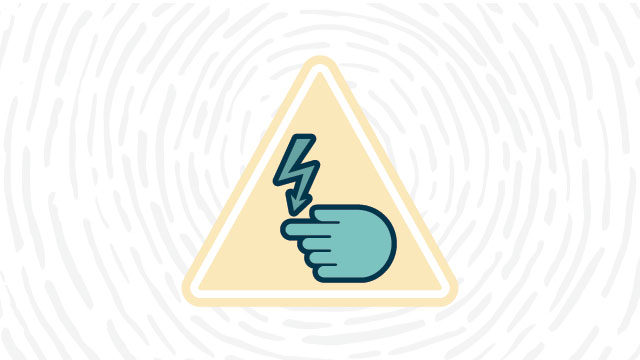
"Electrical hazard" lab safety symbols, which typically include a frayed wire and a hand with a lightning bolt across it, indicates any electrical hazards in the lab. Such hazards can cause anything from a mild tingling to death. With direct current, a person can detect a "tingling" feeling at 1 mA and the median "let-go" threshold (the current at which one cannot release the conductor) is 76 mA. For 60 Hertz alternating current, the values are 0.4 mA and 16 mA, respectively. If an electrical hazard is suspected, the device in question should be disconnected immediately and the cause determined by a qualified and authorized technician. Equipment should always be turned off and unplugged when any work is being done on it. Lock out and de-energizing is required including any capacitors or other stored energy forms.
30. Laser Beam Hazard
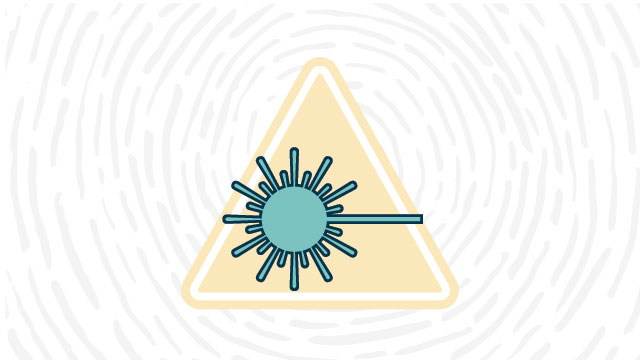
The laser beam hazard sign in the laboratory lets staff know that hazards from laser beams are present. Both the eyes and skin can be damaged from direct exposure to laser beams so proper eye protection and non-flammable clothing should always be always worn in these areas of the lab, whether the laser is being operated or not. Enclosures, laser curtains, do not enter red lights, and signs are also often needed.
31. UV Light Hazard
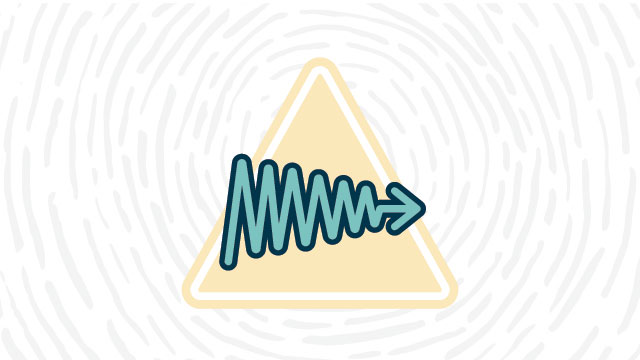
UV light hazard lab safety symbols will appear near ultraviolet (UV) light areas to warn personnel of the potential dangers. UV light is a type of electromagnetic radiation with a wavelength between 180 and 400 nm, which is shorter than those of visible light, but longer than those of X-rays. Health effects due to acute exposure to UV light include redness or ulcerations on the skin, while chronic exposure can lead to skin cancer. The eyes are also at risk from exposures.
32. Glassware Hazard
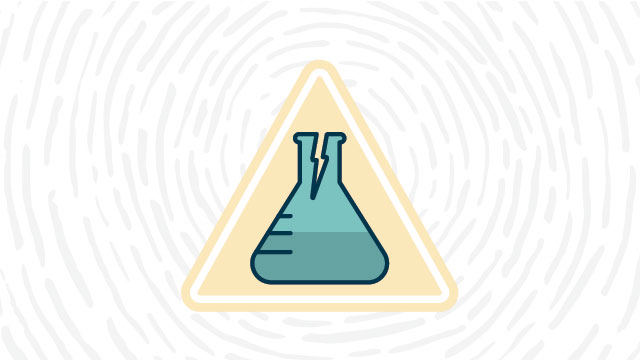
"Broken glassware" lab safety symbols may be placed on a container designated for the disposal of broken glass in the lab. Broken glass is a physical hazard and has the potential to be a health hazard if it is contaminated with toxic chemicals or infectious substances. Wherever possible, laboratories should use plasticware instead of glassware to avoid hazards. Laboratory workers should use forceps, tongs, or a dustpan and brush to clean up pieces of broken glass.
33. Hot Surface
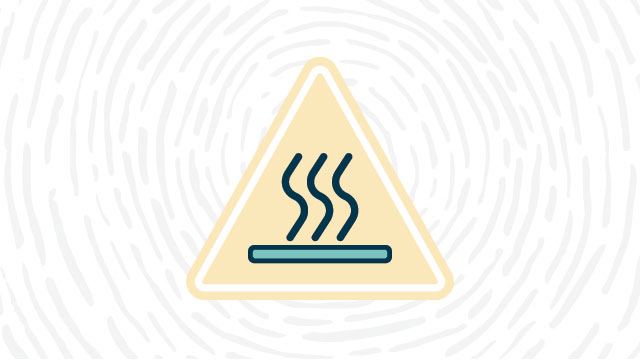
As you’d expect, the hot surface safety sign warns laboratory employees of burn hazards from hot surfaces. Such hazards can come from lab equipment such as lab ovens and autoclaves or from the building itself—if there are steam pipes, etc. Lab workers should avoid touching such surfaces, but if they could come into contact with hot surfaces during their daily work or must handle hot equipment, they should first be trained on how to properly use such equipment and always wear the correct PPE (ex. heat-resistant gloves, heat-resistant face shield).
34. Low Temperature Warning Lab Safety Symbols

The low temperature warning symbol warns staff of cold temperatures or cryogenic hazards in the lab. Such temperatures are usually much lower than freezing point and can be found in cold storage areas of the lab or where chemicals such as liquid nitrogen are stored. PPE for working with cryogenic or low temperature hazards may include: gloves designed for this purpose (thick and made from rubber and cloth, covering the skin up to the elbow), long pants, closed-toe shoes or boots, a rubber apron, and face shield.
Radiation Hazard Lab Safety Symbols
35. Ionizing Radiation Hazard

The ionizing radiation hazard safety sign indicates the presence of ionizing radiation. Ionizing radiation is radiation that carries enough energy to liberate electrons from atoms or molecules, thereby ionizing them. Sources of ionizing radiation in the lab include X-ray apparatus, medical beam cannons, and particle accelerators. Any laboratory possessing or using radioactive isotopes must be licensed by the Nuclear Regulatory Commission (NRC) and/or by a state agency that has been approved by the NRC, 10 CFR 31.11 and 10 CFR 35.12. Labs must limit entry of radionuclides into the human body to quantities as low as reasonably achievable and always within the established limits, and limit exposure to external radiation to levels that are within established dose limits and as far below these limits as is reasonably achievable.
36. Non-Ionizing Radiation Hazard

The non-ionizing radiation hazard sign warns staff of sources of non-ionizing radiation in the lab. Such radiation has a lower frequency and longer wavelength than ionizing radiation. Non-ionizing radiation includes the spectrum of ultraviolet (UV), visible light, infrared (IR), microwave (MW), radio frequency (RF), and extremely low frequency (ELF). Lasers, fluorescent lamps, and some photosensitive chemicals are examples of non-ionizing radiation hazards in the lab. Employee exposure to non-ionizing radiation from any source cannot exceed OSHA standards. Biological safety cabinets, PPE, and engineering controls are some of the measures used to minimize exposure to such hazards.
37. Optical Radiation Hazard
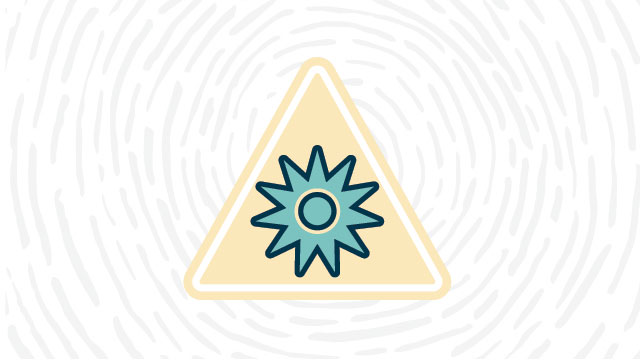
Optical radiation is another term for light, covering ultraviolet (UV) radiation, visible light, and infrared radiation. The optical radiation hazard safety signs warn of equipment that produces this type of radiation in the lab, such as high-powered lasers. When working with such hazards, proper eyewear should always be worn. For lasers in particular, proper SOPs should be in place, the beam path for the laser system should be enclosed, and users should perform a physical survey for any unwanted reflections before using the laser.
38. IAEA Ionizing Radiation Hazard

The International Atomic Energy Agency’s (IAEA) ionizing radiation hazard symbol supplements the regular trefoil symbol for radiation. It includes radiating waves, a skull and crossbones, and a running person to warn of large sources of ionizing radiation. The symbol is meant to be intuitive on its own without needing to know what the trefoil means. It’s aimed toward the general public and anyone in the future, who may not be aware that the trefoil indicates radiation hazards and is placed on sources of radiation that can cause death or serious injury. Typically, it is placed on the device housing the radiation source, rather than doors or containers, to warn people not to take the device apart or get any closer to it.
Other Lab Safety Symbols
39. Dangerous to the Environment

This lab safety symbol indicates that the substance in question can cause damage to the environment and is most often used to label chemicals that are toxic to aquatic wildlife. Environmental hazards are classified as either acute or chronic. Lab workers should dispose of environmentally hazardous materials properly and ensure that they do not get washed down the drain.
40. Flammable & Combustible
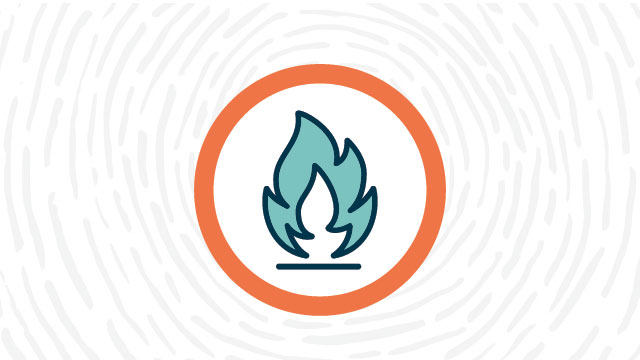
The flammable and combustible lab safety symbol signifies substances that will catch fire in the presence of an ignition source and continue to burn in air. Substances in this category may be gases, aerosols, liquids, or solids, and include many solvents and cleaning materials that are commonly used in the laboratory (e.g., ethyl alcohol). Workers should always keep flammable materials away from open flames, heat, sparks, and ignition sources.
41. Oxidizing Agent
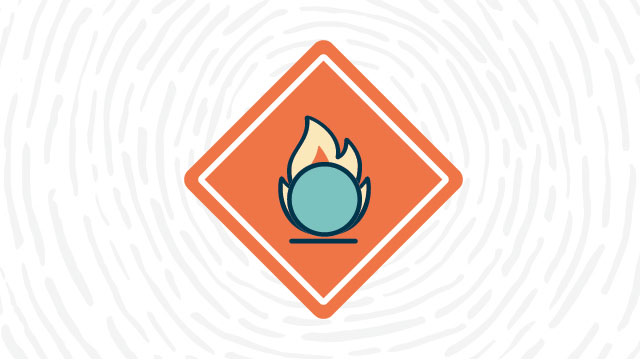
The lab safety symbol for oxidizing materials indicates the presence of chemicals that readily give off oxygen or other oxidizing substances. Oxidizing materials may intensify fires and cause explosions, and may be toxic or corrosive. Although air is the usual source of oxygen for burning, oxidizing materials can support a fire even in the absence of air. Some common oxidizing liquids and solids found in laboratories are bromine, chlorates, nitrates, perchloric acid, and peroxides.
42. Compressed Gas
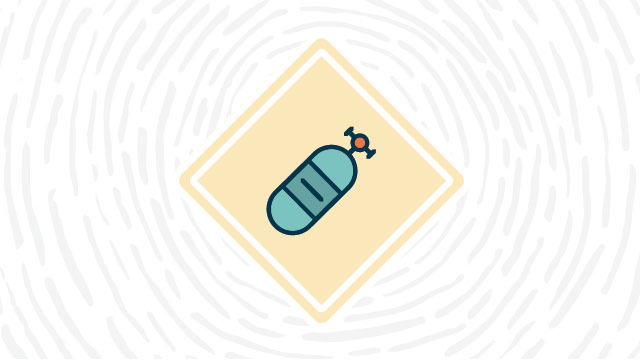
Compressed gases, as indicated by the lab safety symbol, are routinely used in laboratories. There are three major types of gases that get stored under pressure in cylinders: liquefied gases (gases that can become liquids when compressed at room temperature), non-liquefied gases (gases that do not become liquids when compressed at room temperature), and dissolved gases (gaseous reservoir hydrocarbons dissolved in liquid reservoir hydrocarbons). The high pressure within a cylinder makes compressed gases hazardous, as gas can flow rapidly from the cylinder and cause injury, fires, or explosions.
43. Flammable Gas

"Flammable gas" lab safety symbols represent gases that will burn or explode if mixed with air, oxygen, or other in the presence of a source of ignition. Flammable gases used in laboratories include ethyl chloride, aerosols, and liquefied petroleum gas. Compressed flammable gases are common in many labs, and they are extremely dangerous to work with and around.
44. Non-Flammable Gas
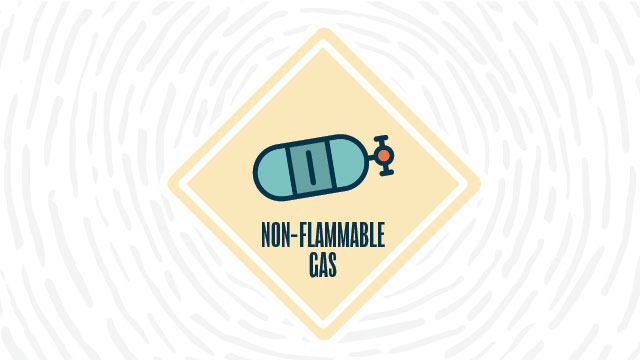
The lab safety symbol for non-flammable gases signifies a division of gases found in labs that encompass compressed gases, liquefied gases, cryogenic gases, compressed gases in solution, and oxidizing gases. Specific examples of non-flammable gases include air, carbon dioxide, Freon, argon, helium, and nitrogen. Although they are not a fire hazard, non-flammable gases displace oxygen and cause asphyxiation or death.
45. Strong Magnetic Field
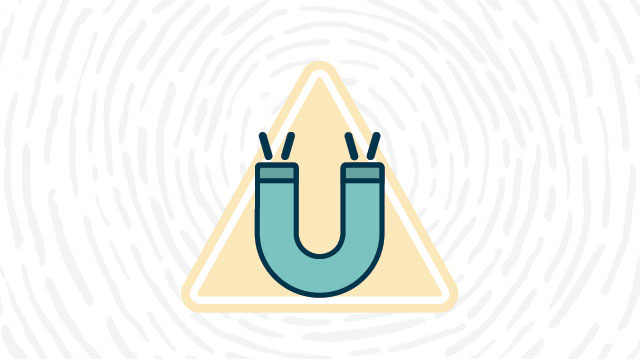
Certain pieces of laboratory equipment generate strong magnetic fields. The strong magnetic field sign alerts lab members to the dangers that this type of equipment can pose. The risks are especially dangerous for people wearing pacemakers and implants, which will tend to align themselves with the magnetic field lines, as will watches, clipboards, and certain tools.
46. Recycling
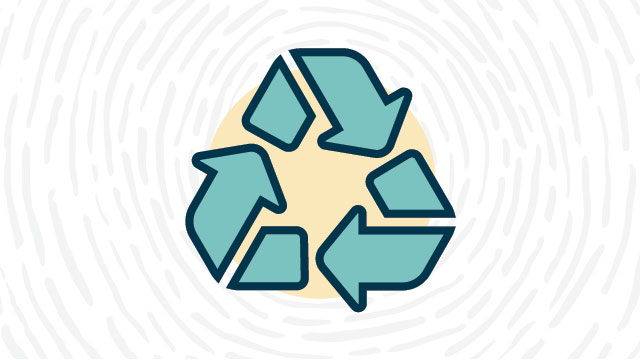
The internationally recognized recycling symbol is formed of three arrows that point in a never-ending loop. They stand for reduce, reuse, recycle and are also referred to as R3. The arrows form a triangle shape. The recycling sign is used in labs to indicate where recyclable items are gathered and sorted. Such items can include Types 1 and 2 laboratory plastics, gloves, pipette tip boxes, Styrofoam containers, cardboard, and any plastic that is not characterized as a biohazard or radioactive hazard. All of these are readily recyclable in most lab facilities. Ask your EH&S or Facility Management representative about recycling in your facility.
To learn more about the fundamentals of ensuring a safe laboratory work environment and tips to build a safety strategy, see our Lab Safety Big Picture series. This in-depth, multi-part series discusses topics like building habits through lab safety activities, embracing safety leadership, creating a successful lab training program, and more.
Lab safety symbols: FAQ
Q: Why are lab safety symbols important?
A: Lab safety symbols are critical in several ways. In the US, employees and employers have a “duty to warn”, which symbols help fulfill. They’re an effectively fast means to recognize and respect the laboratory hazard presented. And they are a consistent and common means of communication accepted in most, if not all, labs.
Q: What should I do if I encounter any lab safety symbols I don't recognize?
A: We should always engage in further discussions on the context and exact nature of the symbol and hazard or control it represents. That way, we’re having helpful conversations even when we do recognize them. And if not, simply ask for clarity of meaning, use, and application. Asking questions is one of the most oft-cited lab safety precepts among lab safety professionals.
Q: Are there specific regulations governing the use of lab safety symbols?
A: Lab safety symbols are meant to be consensus-based hazard information. They’re part of the GHS, or globally harmonized system of classifying and labeling chemicals. This is governed by the United Nations. In addition, there are often regulations for these. In the US, this falls under OSHA (our Occupational Safety and Health Administration) and two of their general industry regulations or standards. These are 1910.145—Specifications for accident prevention signs and tags, and 1910.1200—Hazard communication or “hazcom” for short.
Q: Can lab safety symbols change over time?
A: As with most things, lab safety symbols are subject to change over time. We had less consensus before GHS came into being (1992 start) and was adopted by most countries (most by 2017). Depending on how well they’re followed and how effectively they communicate the hazard, we may see efforts to modify, augment, or replace them individually or in whole.
There has even been an attempt to design a graphic, non-text warning sign for long-term radioactive hazards (due to nuclear power wastes, etc.) that would effectively communicate the risk for 10,000 years when language may be different. So, stay tuned!






